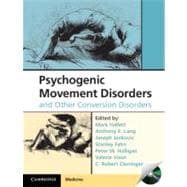
What is included with this book?
| List of contributors | p. vii |
| Preface | p. xi |
| Clinical issues | |
| Introduction to the psychiatry of conversion disorders | p. 1 |
| Phenomenology of psychogenic movement disorders | p. 6 |
| Psychogenic parkinsonism | p. 14 |
| Epidemiology and clinical impact of psychogenic movement disorders | p. 20 |
| The Scottish Neurological Symptoms Study: diagnoses, characteristics, and prognosis in 1144 new neurology outpatients with symptoms unexplained by disease | p. 30 |
| Predisposition and issues of mixed etiology in psychogenic movement disorders | p. 33 |
| Psychogenic movement disorders in children | p. 38 |
| Childhood disorders: another perspective | p. 56 |
| Clinical features and treatment outcome of conversion disorders in children and adolescents | p. 59 |
| Somatoform disorders and psychogenic movement disorders | p. 63 |
| Psychogenic non-epileptic seizures | p. 71 |
| Hypochondriasis and its relationship to somatization | p. 83 |
| Movement disorders in complex regional pain syndrome: the pain field perspective | p. 89 |
| Psychogenic dystonia in psychogenic complex regional pain syndrome | p. 96 |
| Latah and related syndromes | p. 103 |
| Trauma and dissociation: clinical manifestations, diagnosis, epidemiology, pathogenesis, and treatment | p. 106 |
| Psychogenic movement disorders: illness in search of disease? | p. 120 |
| Possible genetic approaches to conversion | p. 134 |
| Physiology | |
| Functional brain imaging of psychogenic paralysis during conversion and hypnosis | p. 143 |
| Action control in conversion paralysis: evidence from motor imagery | p. 160 |
| Imaging in psychogenic movement disorders | p. 168 |
| Imaging in hysterical, hypnotically suggested, and malingered limb paralysis | p. 173 |
| Functional imaging of psychogenic and feigned weakness | p. 180 |
| An fMRI study of recall of causal life events in conversion disorder: preliminary evidence of increased orbitofrontal and parietal activation | p. 184 |
| Cortisol, trauma, and threat vigilance in patients with psychogenic non-epileptic seizures | p. 187 |
| Components of voluntary action | p. 189 |
| Action selection in psychogenic movement disorders | p. 196 |
| Insights from physiology: tremor and myoclonus | p. 199 |
| Physiology of psychogenic dystonia | p. 205 |
| Evoked potentials in the assessment of patients with suspected psychogenic sensory symptoms | p. 209 |
| Characterizing and assessing the spectrum of volition in psychogenic movement disorders | p. 217 |
| Assessment | |
| Rating scales for psychogenic movement disorders | p. 225 |
| Quality of life in psychogenic disorders: the cause, not the effect | p. 231 |
| Psychiatric testing | p. 235 |
| Diagnostic considerations for the assessment of malingering within the context of psychogenic movement disorders | p. 240 |
| Treatment | |
| Prognosis in patients with psychogenic motor disorders | p. 249 |
| Psychogenic movement disorders: explaining the diagnosis | p. 254 |
| Patterns of practice: report of the Movement Disorder Society questionnaire | p. 267 |
| Psychotherapy for psychogenic movement disorders | p. 275 |
| Pharmacotherapy | p. 284 |
| Suggestion | p. 289 |
| Treating psychogenic movement disorders with suggestion | p. 295 |
| Inpatient therapy: trying to transcend pathological dissociation, dependence, and disability | p. 302 |
| Appendix: Psychogenic movement disorders video legends | p. 310 |
| Index | p. 319 |
| Table of Contents provided by Ingram. All Rights Reserved. |
The New copy of this book will include any supplemental materials advertised. Please check the title of the book to determine if it should include any access cards, study guides, lab manuals, CDs, etc.
The Used, Rental and eBook copies of this book are not guaranteed to include any supplemental materials. Typically, only the book itself is included. This is true even if the title states it includes any access cards, study guides, lab manuals, CDs, etc.